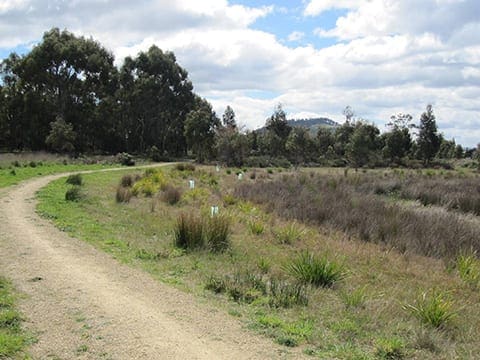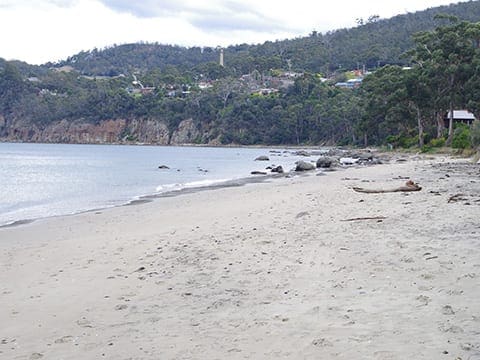Hike at a Glance
Max elevation: 81m
Min elevation: 3m
Total Ascent: 102m
Hike overview
This picturesque site on the Tasman Peninsula once housed up to 600 convicts who laboured in the inky blackness of underground tunnels, chipping at coal and dragging it out on trolleys behind them. Ruins that include the penitentiary, underground cells and mine shaft remain from this brutal past.
Highlights
An outcrop of coal was discovered at Plunkett Point by surveyors in 1833 and immediate plans were made by the government to exploit the area to provide a local supply of coal for the colony. The Plunkett Point mine was the first operational mine in Tasmania.
In 1839 there were 150 prisoners and a detachment of 29 officers stationed at the mines. Large stone barracks which housed up to 170 prisoners, as well as the chapel, bakehouse and store had been erected. Today, they form imposing sandstone ruins. On the hillside above were comfortable quarters for the commanding officer, surgeon and other officials. Remains of some of these can also still be seen. Carts ran along rail and tram roads to the jetties for loading.
Four solitary cells were constructed deep in the underground workings to punish those who committed further crimes at the mines.
By 1847 the main shaft was down over 300 feet with an extensive system of subterranean tunnels and caverns. The work of extracting the coal was carried out by convicts in two eight hour shifts. The men had to extract 25 tons in each shift to reach the day's quota.
The coal mines were subsequently closed by the government in 1848 on both 'moral and financial grounds'.
Tips
Allow 1-2 hours or longer to take in the interpretation panels that tell the story of the site's history. (1km one way)
Toilets. Picnic opportunities; bring your own drinking water and all supplies. Camping is available nearby at Lime Bay.
Level 1. A 300 metre section of track is wheelchair accessible. The rest is a Level 2 walk.
Supervise children, historic site, stay within barriers, deep shafts, building ruins.
No pets, metal detectors or firearms. Bicycles must keep to formed roads. Please assist with conservation by not disturbing any building remnants.
Gallery
Got some great shots from this hike? Upload your photos here to inspire others and show off the beauty of the trail!
Click to view form >>
Submitting your photos doesn’t mean you lose ownership. You can be credited for your contributions, and you can request removal at any time.
Content use
Please don’t copy GPX files or content from this site to AllTrails or other platforms. Each trail has been personally mapped, documented, and refined to support Australia’s bushwalking and hiking community. While some details come from land managers, every listing reflects significant personal effort. This is a free, community-driven initiative—your respect helps keep it that way.
Walk map and GPX file
Max elevation: 81 m
Min elevation: 3 m
Total climbing: 102 m
Total descent: -102 m
For more information about this hiking trail please visit Parks and Wildlife Service Tasmania
Getting there
Getting to the trailhead: Coal Mines Historic Site.
Travel on road B37 from Taranna or Nubeena on the Tasman Peninsula. At Premaydena take road C 341 for approximately 13km. The final 3km is unsealed.
Closest towns to this walk: Dunalley, Eaglehawk Neck, Nubeena, Port Arthur, Taranna
Similar walks nearby
Looking for more walks in or near Coal Mines Historic Site? Try these trails with a similar difficulty grade.
Track grade
Grade 2 (Easy) - A Gentle Introduction to Inclines: Grade 2 on the AWTGS represents easy walking tracks that offer a slightly more challenging experience compared to Grade 1. Similar to Grade 1, no prior bushwalking experience is required. The track surface is typically hardened or compacted and may have gentle hill sections or occasional steps. The total distance of a Grade 2 walk is typically no greater than 10 kilometers. These walks are still suitable for families with a bit more experience or those seeking a gentle introduction to some inclines.
Explore safe
Plan ahead and hike safely! Carry enough water, pack layers for changing conditions, and bring safety gear like a torch, PLB, and reliable communication device. Check official sources for trail updates, closures, and access requirements, and review local weather and bushfire advice. Most importantly, share your plans with someone before you go. Being prepared makes for a safer and more enjoyable hike! Stay Safe, Explore More, and Always #ExploreSafe.
Packing checklists
What you carry in your pack depends on factors like weather, terrain, and your adventure type. Not sure what to bring? My free planning, food, and packing checklists are a great starting point, covering day hikes, overnight trips, and multi-day adventures. Use them to customise your kit and always prioritise safety.
Let someone know
Before heading out, take a moment to fill out your trip intentions form. It’s a quick way to share your hike details with family or friends. If something goes wrong, they can notify emergency services, ensuring a faster response and peace of mind. Stay safe and enjoy your adventure
Suggest an edit
Spotted a change on this trail? Maybe there are new features, the route has shifted, or the trail is permanently closed. Whatever the update, I’d love your input. Your feedback helps fellow hikers stay informed and ensures that our trail info stays fresh and reliable.
Acknowledgement of Country
Trail Hiking Australia acknowledges the Traditional Owners of the lands on which we hike and pay respects to their Elders, past and present, and we acknowledge the First Nations people of other communities who may be here today.






